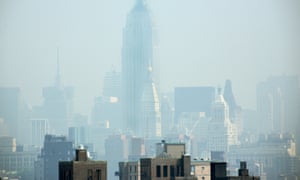Previous investigations fail to reveal impact of ‘world’s largest human health threat’ because they do not account for people’s movement, researchers say

The true impact of air pollution has been obscured by the failure to consider people’s exposure as they move around during the day, according to a new study that has mapped the hotspots of New York’s air pollution based on where people gather for work or recreation.
The research cites air pollution as “the world’s single largest environment and human health threat” but laments that the problem has not previously been “considered spatially and temporally”, with most studies basing a person’s pollution exposure on where they live.
Using information obtained from cellphone towers, the researchers were able to build up a picture of millions of New Yorkers’ movements over the course of 120 days. They used a formula that charts population density as well as pollution levels to look at how people’s exposure to PM2.5, an airborne particle linked to an array of health problems, varies according to where they typically congregate during the day.
The researchers found that areas of midtown and lower Manhattan, which have some of the highest PM2.5 levels, saw large numbers of people exposed during the day, but less so at night. Conversely, areas of southern Brooklyn with high PM2.5 levels peaked in pollution exposure at night as people returned to their neighborhoods after work. Areas of Queens near LaGuardia airport remained elevated throughout the day.
Concentrations of PM2.5 also vary throughout the day and affect the identification of hotspots, depending on factors including power generation and traffic.

